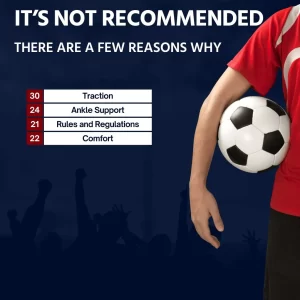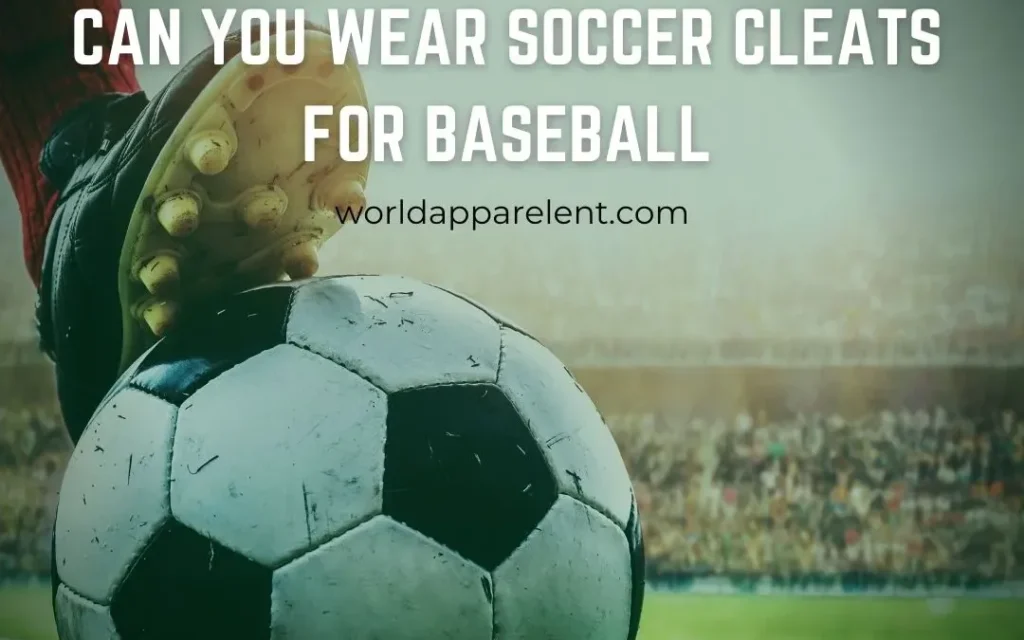Soccer cleats and baseball cleats have a few distinct differences. Soccer cleats have a lower cut, a lighter weight, and a more flexible sole. On the other hand, baseball cleats have a higher cut, more ankle support, and a more rigid sole. However, it’s common to wonder if you can wear soccer cleats for baseball, especially if you have a pair on hand and don’t want to purchase a new pair of baseball cleats.
In short, it is possible to wear soccer cleats for baseball, but it’s not recommended. There are a few reasons why:

- Traction: Baseball cleats have metal spikes or plastic cleats that are designed to grip the field, particularly the dirt and grass. Soccer cleats, on the other hand, have shorter and fewer studs, designed for traction on a different surface. Using soccer cleats on a baseball field can affect your grip and cause slipping, particularly on wet or muddy fields. This can be especially dangerous for baseball players who need to make quick, sudden movements.
- Ankle Support: Baseball requires a lot of lateral movement, and a high-top cleat provides extra support to help prevent ankle injuries. Soccer cleats, with their low-cut design, don’t offer the same level of ankle support.
- Rules and Regulations: Some baseball leagues have specific rules regarding the type of cleats that players can wear. It’s important to check with your league to ensure that soccer cleats are allowed. In many cases, only baseball-specific cleats are permitted on the field.
- Comfort: While soccer cleats are designed to be comfortable and flexible for running and kicking, they may not provide the same level of comfort and protection for baseball players who need to stand in place for extended periods of time, particularly while waiting for a ball to come their way. Additionally, soccer cleats may not fit as snugly as baseball cleats, leading to discomfort or even blisters.
Benefits of Soccer Cleats
Soccer cleats, also known as football boots, are specifically designed footwear for soccer players. They offer several benefits that can help players improve their game and protect themselves from injuries. Here are some of the main benefits of soccer cleats:
- Traction: Soccer cleats are designed to provide maximum traction on grass and turf surfaces. The studs or cleats on the sole of the shoe are strategically placed to provide excellent grip and stability, allowing players to make quick turns and change direction easily.
- Control: Soccer cleats often feature a textured surface on the upper part of the shoe, which can help players maintain better control of the ball. This feature is especially useful for players who need to dribble and pass the ball accurately.
- Comfort: Soccer cleats are designed to be lightweight and comfortable, making it easier for players to run and move around the field. They also have features like padded insoles and breathable materials that help prevent blisters and keep feet cool and dry during a game.
- Protection: Soccer cleats provide protection for the feet and ankles while playing. The design of the shoe, including a low-cut or mid-cut style, can offer support to prevent injuries like sprains and twists.
- Style: Soccer cleats come in a wide range of styles and colors, allowing players to express their individuality and personal style. This can be especially important for younger players who want to stand out on the field and feel confident while playing.
Types of Soccer Cleats
There are several different types of soccer cleats available, each with its own unique design and features. Here are some of the most common types of soccer cleats:
- Firm Ground (FG) Cleats: Firm Ground cleats are the most common type of soccer cleats and are designed for use on natural grass surfaces. They have molded studs or blades on the sole of the shoe, which provide excellent traction on firm, dry grass.
- Soft Ground (SG) Cleats: Soft Ground cleats are designed for use on wet or muddy grass fields. They have longer studs or blades on the sole of the shoe, which help prevent slipping on slick surfaces.
- Artificial Ground (AG) Cleats: Artificial Ground cleats are designed for use on synthetic turf surfaces. They have short, rubber studs on the sole of the shoe, which provide excellent traction on artificial grass.
- Indoor Cleats: Indoor soccer cleats are designed for use on indoor soccer fields or other hard, indoor surfaces. They have a flat, non-marking rubber sole, which provides excellent traction and grip on smooth surfaces.
- Turf Cleats: Turf soccer cleats are designed for use on artificial turf or hard, outdoor surfaces. They have small, rubber studs on the sole of the shoe, which provide excellent traction and grip on harder surfaces.
- Mid-Cut Cleats: Mid-cut soccer cleats are designed to provide extra ankle support and protection. They have a higher cut around the ankle, which helps prevent ankle injuries and provides extra stability during lateral movements.
- Low-Cut Cleats: Low-cut soccer cleats are designed to be lightweight and provide maximum speed and agility. They have a low-cut design, which allows for greater range of motion and flexibility.
Conclusion
while it is possible to wear soccer cleats for baseball, it’s not recommended. It’s important to invest in a pair of baseball-specific cleats for maximum comfort, protection, and performance. If you’re unable to purchase a new pair of cleats, consider borrowing from a teammate or checking with local sporting goods stores to see if they have any used or discounted options available.

